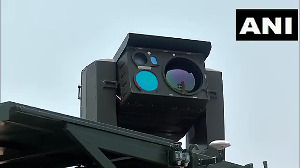It's one of life's many wonders until God's priceless creation stops walking on Earth for good, notes Ronjita Kulkarni.

Have you ever seen a tiger?
No, not in a book or on television. Or even in a zoo.
Have you seen a tiger in the wild, just a few metres away from you?
It's a surreal feeling.
The tiger is such a magnificent being, so graceful, and so sure of its might that it will not even give you a second look.
We were lucky enough to see a tigress and her four cubs at the Tadoba National Park in Maharashtra. While that was an experience we will never forget, the way the jungle safari started was just as unforgettable.
We arrived at the forest gate -- there are many in Tadoba; we went to the Neemdhela gate -- at 6:30 am, and were led to our open jeep.
The vast forests at Tadoba consist mostly of bamboo trees. It’s very quiet inside the jungle, with just the sound of the birds and of course, our jeep. As we were cruising along, our driver was suddenly alerted of a tiger in a certain area of the jungle.
And that's when it started...

The driver immediately picked up speed -- and it seemed like jet speed here! -- and he raced like an F1 driver along the rough jungle roads. We had to duck low branches and hold on to the jeep for our dear lives, as he raced along, trying to make sure we got to see what he probably sees daily.
The forest, which looked deserted up until this point, suddenly woke up to the arrival of more jeeps. Soon, there were so many, it seemed like regular Mumbai traffic!
The drivers and guides started talking excitedly about where the tiger was spotted and where he would likely emerge from. They exchanged opinions about where the best vantage point would be. After several calculations, arguments and then some more calculations, we set off again, this time slowly. The jeeps stopped near a clearing.
The clearing was actually a shallow pond, and the tiger was resting in it, half in, half out.
We were told that the tiger -- named Bhanushkindi after the area where she was found -- had just eaten and was cooling off in the water.
But the sight was far off in the distance, and the drivers weren’t impressed.
They wanted to give us a closer look.
So we waited.
And while we did, a quiet descended upon the jeeps -- there were 14 of them -- as everyone wordlessly hoped the tiger would get up and come closer.

There's no rushing a tiger, of course.
So it was a good 10 minutes when it finally rose, and sauntered ahead.
Oh, but it was going the 'wrong' way, further away from us.
That's when we saw some movement in the shrubs ahead, and we spotted a couple more tigers. We were told that they were Bhanushkindi's four clubs, aged eight months. One of the cubs is named Simba and he has the pattern of a man's head on his neck; we were quickly shown its picture, and the resemblance is uncanny.
The cubs, however, did not want to leave the safety of those shrubs. Perhaps they weren't used to 14 jeeps, with people craning out of them, crowding around their natural habitat. The tigress, of course, had no such worries.
Still, she moved further away from us.
The jeeps came alive again, and we raced towards another part of the jungle. The reason we took longer to get there is because while the tiger can walk anywhere on the terrain, the jeeps have to follow the road.

After a frightening five minutes of superfast driving, we arrived at on the side where the tiger was expected to emerge from. But this time, the drivers weren't in agreement with each other. Our driver, who seemed to be the most dedicated to giving us the best view, was arguing with the others to stop blocking the tiger's way, so that she could cross the road and give us an unforgettable sight.
But the others wouldn't give way. Everyone wanted the best seats in the house!
A lot of arguments ensued, echoing through the forest, and finally, the jeeps moved accordingly.
It was as if the tiger knew what was happening and was patiently waiting for the jeeps to make up their minds. She emerged right away, barely a few metres away from us, and crossed the road without bothering to look around.
As everyone, including the jeep drivers and guides, watched almost open-mouthed, many others from behind their camera lenses, it gave birth to a memory no one in those 14 jeeps would ever forget.
Have you ever seen a tiger in the wild?
It's one of life's many wonders until God's priceless creation stops walking on Earth for good.
Quick Facts About Tadoba
The nearest airport and railway station is Nagpur. From Nagpur, one can take a cab to Taboda. Or the forest hotels where you are staying can arrange transfers.
Distance from Nagpur airport to Tadoba is three hours, and costs Rs 4,000, one way.
Distance from the railway station to Tadoba is four hours and also Rs 4,000 one way.
We stayed at Nature's Sprout, for Rs 4,000 per night, where the service was amazing, but the rooms were not exactly value for money.
A safari jeep excursion will set you back by Rs 4,800 and goes from the jungle gates. To get to the jungle gates from the hotel you're staying at costs more, and depends on how far it is from the gates. For instance, the Neemdhela gate was an hour away from our hotel, and it cost Rs 2,500 to get to the gates.
The morning safaris start at 6.30 am, afternoon safari at 3.30 pm and the night safari at 7 pm.
One is not allowed to take pictures from cell phones, as the constant clicking may upset the tigers. One can only take pictures from cameras.












 © 2025
© 2025